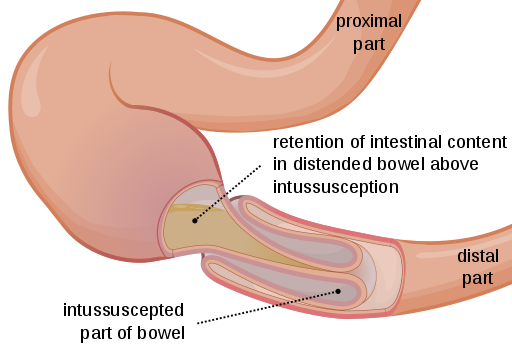Sandbox SSW: Difference between revisions
Sargun Walia (talk | contribs) |
Sargun Walia (talk | contribs) |
||
| Line 34: | Line 34: | ||
Under normal conditions, a balance between the longitudinal and radial forces maintains the normal structure of intestine. Intussusception occurs if there is an imbalance between the longitudinal forces. This imbalance leads to a segment of intestine to invaginate into another segment and cause entero-enteral intussusception. The proximal portion is called intussusceptum and the distil portion is called intussuscipien. If this telescoping of the intestine continues it can extend till distil colon or sigmoid colon or even through the anus. | Under normal conditions, a balance between the longitudinal and radial forces maintains the normal structure of intestine. Intussusception occurs if there is an imbalance between the longitudinal forces. This imbalance leads to a segment of intestine to invaginate into another segment and cause entero-enteral intussusception. The proximal portion is called intussusceptum and the distil portion is called intussuscipien. If this telescoping of the intestine continues it can extend till distil colon or sigmoid colon or even through the anus. | ||
[[File:512px-Intussusception EN.svg.png|center|500px|frame|Intussusception(Source: By Olek Remesz (wiki-pl: Orem, commons: Orem) (Own work) [CC BY-SA 3.0 (https://creativecommons.org/licenses/by-sa/3.0)], via Wikimedia Commons)]] | |||
{{Family tree/start}} | {{Family tree/start}} | ||
Revision as of 15:47, 22 November 2017
Editor-In-Chief: C. Michael Gibson, M.S., M.D. [1]; Associate Editor(s)-in-Chief: Sargun Singh Walia M.B.B.S.[2]
Overview
The exact pathogenesis of intussusception is not fully understood. It is thought that intussusception is the result of / is mediated by / is produced by / is caused by either [hypothesis 1], [hypothesis 2], or [hypothesis 3].
OR
[Pathogen name] is usually transmitted via the [transmission route] route to the human host.
OR
Following transmission/ingestion, the [pathogen] uses the [entry site] to invade the [cell name] cell.
OR
[Disease or malignancy name] arises from [cell name]s, which are [cell type] cells that are normally involved in [function of cells].
OR
The progression to [disease name] usually involves the [molecular pathway].
OR
The pathophysiology of [disease/malignancy] depends on the histological subtype.
Pathophysiology
Pathogenesis
The exact pathogenesis of intussusception is not fully understood. Under normal conditions, a balance between the longitudinal and radial forces maintains the normal structure of intestine. Intussusception occurs if there is an imbalance between the longitudinal forces. This imbalance leads to a segment of intestine to invaginate into another segment and cause entero-enteral intussusception. The proximal portion is called intussusceptum and the distil portion is called intussuscipien. If this telescoping of the intestine continues it can extend till distil colon or sigmoid colon or even through the anus.

| Types | |||||||||||||||||||||||||||||||||||||||||||||||||||||||
| Ileocolic | Ileo-Ileo-Colic | Jejuno-jejunal | Jejuno-Ileal | Colo-Colic | |||||||||||||||||||||||||||||||||||||||||||||||||||
- Intussusception is the most common abdominal emergency in children < 2 years of age.
| Children | |||||||||||||||||||
| Idiopathic- no lead point | Pathologic- Lead point | ||||||||||||||||||
- uncommon in adults but when it occurs the most common cause is pathological due to lead point.
If the mesentry invaginates along with the intestine it can lymphatic and venous congestion leading to intestinal edema. If not treated then eventually it leads to ischemia which further can lead to peritonitis or even perforation.
Etiology
- Idiopathic
- Most common cause (75%)
- Disease trigger or lead point cannot be recognised
- Viral Cause
- Seasonal viral gastro-enteritis.[1]
- Rotavirus Vaccine:- Intussusception is known to be caused by certain types of Rotavirus Vaccines. An earlier iteration of the vaccine known as the Rotashield was taken out of the market because it was associated with an increased number of cases of intussusception. If there occurs any case of intussusception after vaccination with rotavirus vaccine, then it should be reported to the Vaccine Adverse Event Reporting System (VAERS) by the providers.[2]
- Adenovirus:- There is a strong association with adenovirus infection. A case control study conducted in Vietnam and Australia shows that Specie C of adenovirus is a strong predictor of intussusception in children.[3]
OR
- It is thought that [disease name] is the result of / is mediated by / is produced by / is caused by either [hypothesis 1], [hypothesis 2], or [hypothesis 3].
- [Pathogen name] is usually transmitted via the [transmission route] route to the human host.
- Following transmission/ingestion, the [pathogen] uses the [entry site] to invade the [cell name] cell.
- [Disease or malignancy name] arises from [cell name]s, which are [cell type] cells that are normally involved in [function of cells].
- The progression to [disease name] usually involves the [molecular pathway].
- The pathophysiology of [disease/malignancy] depends on the histological subtype.
Genetics
- [Disease name] is transmitted in [mode of genetic transmission] pattern.
- Genes involved in the pathogenesis of [disease name] include [gene1], [gene2], and [gene3].
- The development of [disease name] is the result of multiple genetic mutations.
Associated Conditions
Gross Pathology
- On gross pathology, [feature1], [feature2], and [feature3] are characteristic findings of [disease name].
Microscopic Pathology
- On microscopic histopathological analysis, [feature1], [feature2], and [feature3] are characteristic findings of [disease name].
References
- ↑ Buettcher M, Baer G, Bonhoeffer J, Schaad UB, Heininger U (2007). "Three-year surveillance of intussusception in children in Switzerland". Pediatrics. 120 (3): 473–80. doi:10.1542/peds.2007-0035. PMID 17766518.
- ↑ Shimabukuro TT, Nguyen M, Martin D, DeStefano F (2015). "Safety monitoring in the Vaccine Adverse Event Reporting System (VAERS)". Vaccine. 33 (36): 4398–405. doi:10.1016/j.vaccine.2015.07.035. PMC 4632204. PMID 26209838.
- ↑ Bines JE, Liem NT, Justice FA, Son TN, Kirkwood CD, de Campo M, Barnett P, Bishop RF, Robins-Browne R, Carlin JB (2006). "Risk factors for intussusception in infants in Vietnam and Australia: adenovirus implicated, but not rotavirus". J. Pediatr. 149 (4): 452–60. doi:10.1016/j.jpeds.2006.04.010. PMID 17011313.